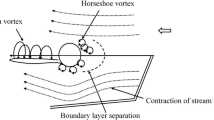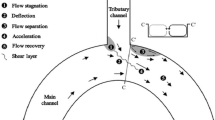Abstract
The intricacy of sedimentation and its transport in alluvial channels is a matter of great apprehension in the arena of hydraulic engineering. In this perspective, a submerged vane plays a dynamic part by providing an effective and efficient solution of sediment management. An immersed vane structure acts as a vortices-generating contrivance that can be employed for controlling the channel bed erosion in streams. The flow pattern downstream of the vane can be transformed by fixing the vanes on the stream bed at a certain angle, resulting in the modification of shear stress and sediment redistribution on the channel bed. Immersed vanes have found numerous functions in channel hydraulics, but commonly, immersed vanes are applied to generate optimal riverbed depth, to diminish unnecessary scour or sediment deposition, and an overall improvement of navigability. In the present study, four clearwater experiments are performed using rectangular single, double, and triple vanes arrangements to analyze the equilibrium scour pattern around the vanes positioned at 150 angle of attack The contours of scouring holes developed around the immersed vanes are plotted. From the evaluation of the scour geometries and contours morphology around such arrangements of submerged vanes, it is observed that for each set of arrangement, there is a variation in the scour formation in the upstream and downstream side of the flow, which in turn gives a clear idea about the scour patterns around them. The scours are observed to be more for the downstream vanes in the case of multiple vanes in comparison with a single vane. The horseshoe vortex and wake vortex are much stronger at the place near to the vane. The experimental study provides an insight into the proper design and placement of vanes which could be further utilized for more effective channelizing of sediments toward the bank, enhancing the navigability of the channel.
Access this chapter
Tax calculation will be finalised at checkout
Purchases are for personal use only
Similar content being viewed by others
References
Breusers HNC, Nicollet G, Shen HW (1977) Local scour around cylindrical piers. J Hydraul Res 15(3):211–252
Dargahi B (1990) Controlling mechanism of local scouring. J Hydraul Eng 116(10):1197–1214
Pandey M, Sharma PK, Ahmad Z, Karna N (2017) Maximum scour depth around bridge pier in gravel bed streams. Nat Haz 91(2):819–836
Barbhuiya AK, Dey S (2004) Local scour at abutments: a review. Sadhana 29:449–476
Das S, Mazumdar A (2018) Evaluation of Hydrodynamic Consequences for Horseshoe Vortex System developing around two eccentrically arranged Identical Piers of Diverse Shapes. KSCE J. Civil Eng. 22(7):2300–2314
Das R, Khwairakpam P, Das S, Mazumdar A (2014) Clear-water local scour around eccentric multiple piers to shift the line of sediment deposition. Asian J Water Environ Pollut 11(3):47–54
Rout A, Sarkar A (2020) Local scour around submerged tandem and offset cylinders due to change in alignment angle. Proc Inst Civil Eng: Water Manag 173(1):14–30
Das S, Mazumdar A (2015) Turbulence flow field around two eccentric circular piers in scour hole. Int J River Basin Manag. 13(3):343–361
Das S, Das R, Mazumdar A (2014) Variations of clear water scour geometry at piers of different effective widths. Turk J Eng Environ Sci 38(1):97–111
Das S, Das R, Mazumdar A (2014) Vorticity and circulation of horseshoe vortex in equilibrium scour holes at different piers. J Inst Eng India Ser A 95(2):109–115
Voskoboinick V, Nikishov VI, Voskoboinick A, Voskoboinick A (2014) Influence of grouping of the bridge piers on scour. Sci Based tech 22(2):229–235
Jaman H, Das S, Das R, Mazumdar A (2017) Hydrodynamics of flow obstructed by inline and eccentrically-arranged circular piers on a horizontal bed surface. J Inst Eng India Ser A 98(1–2):77–83
Das S, Ghosh S, Mazumdar A (2014) Kinematics of horseshoe vortex in a scour hole around two eccentric triangular piers. Int J Fluid Mech Res 41(4):296–317
Jaman H, Das S, Kuila A, Mazumdar A (2017) Hydrodynamic flow patterns around three inline eccentrically arranged circular piers. Arab J Sci Eng 42(9):3973–3990
Solaimani N, Amini A, Banejad H, Ghazvinei PT (2017) The effect of pile spacing and arrangement on bed formation and scour hole dimensions in pile groups. Int J River Basin Manag 15(2):219–225
Das S, Das R, Mazumdar A (2016) Comparison of local scour characteristics around two eccentric piers of different shapes Arab. J Sci Eng 41(4):1193–1213
Odgaard AJ, Spoljaric A (1986) Sediment control by submerged vanes. J Hydraul Eng 112(12):1164–1180
Odgaard AJ, Mosconi CE (1987) Streambank protection by submerged vanes. J Hydraul Eng 113(4):520–536
OdgaardAJ, Wang Y (1991) Sediment management with submerged vanes. I: theory. J Hydraul Eng 117(3):267–283
Odgaard AJ, Wang Y (1991) Sediment management with submerged vanes. II: applications. J Hydraul Eng 117(3):284–302
Marelius F, Sinha SK (1998) Experimental investigation of flow past submerged vanes. J Hydraul Eng 124(5):542–545
Johnson PA, Hey RD, Tessier M, Rosgen DL (2001) Use of vanes for control of scour at vertical wall abutments. J Hydraul Eng 127(9):772–778
Flokstra C (2006) Modelling of submerged vanes. J Hydraul Res 44(5):591–602
Ghorbani B, Kells JA (2008) Effect of submerged vanes on the scour occurring at a cylindrical pier. J Hydraul Res 46(5):610–619
Bejestan MS, Azizi R (2012) Experimental investigation of scour depth at the edge of different submerged vanes shapes. World Environ Water Resour Cong ASCE 1376–1385
Das S, Mukherjee R, Das R, Mazumdar A (2017) Enhancement of sediment transportation by increasing scour around a square pier with vane attached on one side. Proc 37th IAHR World Congress Malaysia, 565–574
Bejestan MS, Khademi K, Kozeymehnezhad H (2015) Submerged vane-attached to the abutment as scour Countermeasure. Ain Shams Eng. J. 6(3):775–783
Sharma H, Jain B, Ahmad Z (2016) Optimization of submerged vane parameters. Sadhana 41(3):327–336
Das S, Das R, Mazumdar A (2015) Velocity profile measurement technique for scour using ADV. Int Conf testing and measurement: techniques and applications (TMTA)—Chan (ed), Taylor and Francis Group, London, 249–252
Ouyang H (2009) Investigation on the dimensions and shape of a submerged vane for sediment management in alluvial channels. J Hydraul Eng 135(3):209–217
Author information
Authors and Affiliations
Editor information
Editors and Affiliations
Rights and permissions
Copyright information
© 2022 The Author(s), under exclusive license to Springer Nature Singapore Pte Ltd.
About this paper
Cite this paper
Roy, P., Das, S., Dey, A., Das, R. (2022). Analytical Study of Scour Mechanism Around Immersed Rectangular Vane Structures. In: Rao, C.M., Patra, K.C., Jhajharia, D., Kumari, S. (eds) Advanced Modelling and Innovations in Water Resources Engineering. Lecture Notes in Civil Engineering, vol 176. Springer, Singapore. https://doi.org/10.1007/978-981-16-4629-4_49
Download citation
DOI: https://doi.org/10.1007/978-981-16-4629-4_49
Published:
Publisher Name: Springer, Singapore
Print ISBN: 978-981-16-4628-7
Online ISBN: 978-981-16-4629-4
eBook Packages: EngineeringEngineering (R0)




